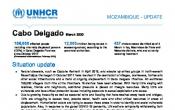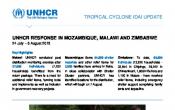Mozambique
Operation: Mozambique
Location
{"longitude":34,"latitude":-18,"zoom_level":5,"iso_codes":"'MOZ'"}
By clicking on the icons on the map, additional information is displayed.
The boundaries and names shown and the designations used on this map do not imply official endorsement or acceptance by the United Nations.
Key Figures
| 2019 year-end results | |
| 351,500 | IDPs were provided with general protection services |
| 3,360 | individuals were registered by the Government |
| 85% | of people of concern had access to primary health care |
| 60% | of people of concern had access to national education systems |
| 280 | 280 people of concern received life-skills training for livelihood purposes |
| 100 | community-based protection focal points were trained and supported to conduct outreach protection activities in the Idai-affected resettlement sites |
| 170 | people of concern received legal assistance |
| 2020 planning figures | |
| 100% | of people of concern opting for local integration have been locally integrated |
| 100% | of primary school-aged children will be enrolled in primary education |
| 85% | of people of concern registered on an individual basis |
| 80% | of people of concern graduated from livelihood trainings employed after three months |
People of Concern
371%
Increase in
2019
2019
| 2019 | 206,207 |
| 2018 | 43,736 |
| 2017 | 45,035 |

[["Refugees",4708],["Asylum-seekers",20983],["IDPs",180516]]
Loading ...
Mozambique
< Back
2019
{"categories":[2015,2016,2017,2018,2019,2020],"budget":[5.14927993,5.50288191,5.52294825,5.94621359,9.05979366,9.6878531],"expenditure":[2.89281237,2.77095579,3.25396842,3.9230942,6.04628116,null]}
{"categories":[2015,2016,2017,2018,2019,2020],"p1":[4.76918068,5.11505699,5.39732245,5.62665857,5.83019729,7.392050019999999],"p2":[0.38009925,0.38782491999999996,0.1256258,0.31955502,0.11797337,0.22613207999999999],"p3":[null,null,null,null,null,null],"p4":[null,null,null,null,3.111623,2.069671]}
{"categories":[2015,2016,2017,2018,2019,2020],"p1":[2.71037374,2.60526196,3.23707626,3.8018527,3.86719339,null],"p2":[0.18243863000000002,0.16569383,0.01689216,0.1212415,0.09382781,null],"p3":[null,null,null,null,null,null],"p4":[null,null,null,null,2.08525996,null]}
Loading ...
CHOOSE A YEAR
- 2015
- 2016
- 2017
- 2018
- 2019
- 2020
Operational context
Mozambique has traditionally offered progressive practical arrangements for refugees to have access to work and public services. In the last few years, refugee issues were increasingly addressed by the Ministry of Interior, culminating in 2019 with the creation of an inter-ministerial conference on security and refugee matters. The Government sought international assistance to deal with the consequences of natural disasters – cyclones Idai and Kenneth, compounded by seasonal droughts. As part of the joint inter-agency response to Tropical Cyclone Idai, UNHCR co-led the protection cluster and provided shelter and core relief items to affected people. In addition, UNHCR established its presence and led the protection cluster in Cabo Delgado Province, which was impacted by Tropical Cyclone Kenneth in April 2019.In 2019, UNHCR advocated with the Government to address the backlog of refugee status determination applications pending for over 24,000 asylum-seekers. The operation also advocated for the Government to lift its reservations to the 1951 Refugee Convention in order to promote greater legal protection for refugees and asylum-seekers, especially given that the reservations no longer reflected the practice in Mozambique, where favourable local integration opportunities existed.
Population trends
As of December 2019, Mozambique hosted some 4,700 refugees and 21,000 asylum-seekers, of whom 37% were girls and women and 30% children. Some 11% of refugees and asylum-seekers lived in Nampula City, 36% lived in Maratane settlement and the remaining 53% lived in the Maputo area and other provinces of the country. The Maratane refugee settlement hosted some 9,240 asylum seekers and refugees, of whom 46% of the population was composed by girls and women, and 52% were under 18 years old. The majority of refugees were from the Democratic Republic of the Congo, Burundi, Rwanda and Somalia.As a result of drought in the southern provinces, Tropical Cyclones Idai and Kenneth in central and northern Mozambique, and violence in the Cabo Delgado Province, some 180,500 people were internally displaced.
Achievements
- More than 20 partners and authorities were trained in sexual and gender-based violence prevention and response, and protection against sexual exploitation and abuse.
- Mentoring and cash-based support to refugees resulted in an increase in self-reliance and reduced dependency on aid.
- Over 30 refugee students were enrolled in higher education in Mozambique (Nampula, Ilha de Mocambique, Beira and Maputo), with support from the Albert Einstein German Academic Refugee Programme (DAFI).
- Biometric verification was carried out in Maratane settlement and most of the provinces, improving monitoring of secondary movements and double registration.
- As part of UNHCR’s response to Cyclone Idai, various protection activities were successfully conducted in 2019 including protection monitoring in settlement sites, community-based protection activities, capacity-building of local partners and national authorities, protection risk assessments, and protection mainstreaming across all sectors of the response.
Unmet needs
- The operation was funded at 20% in 2019.
- More livelihood opportunities were needed to promote greater inclusion and self-reliance for refugees and asylum-seekers in Mozambique, particularly for those residing in Maratane settlement.
- Schools were struggling with limited capacity to absorb additional children in displacement-affected areas. The distance from schools, lack of materials and lack of documentation further impeded access to education for school-age IDPs.
- In relation to livelihoods, due to the lack of funding and personnel with subject matter expertise, the creation of additional job opportunities through value chain development was postponed to 2020.
Operational Environment
After three years of internal political strife in Mozambique, the peace process concluded in 2018 has resulted in a revision of the Constitution and the integration of the former combatants of the opposition movement into the armed forces and police. In this stabilizing political context, the majority of the Mozambican asylum-seekers in Zimbabwe are expected to return spontaneously in 2019. In addition, due to continued political instability in both Burundi and the Democratic Republic of Congo, the number of new arrivals is expected to remain at some 160 people per month. The estimated number of people of concern in Mozambique in 2019 stands at some 37,800.The quality of asylum in Mozambique remains relatively good, despite reservations to the 1951 Refugee Convention and Protocol. The Government adopted the new United Nations Conventional Travel Documents (UNCTDs), issues new refugee cards, registers births of refugee and asylum-seeker children, as well as allows people of concern access to primary and secondary education, public health care, and engagement in economic activities and gainful employment in the formal and informal sectors. Although Mozambique continues to welcome new asylum-seekers, no refugee status determination decisions have been signed by the Minister of Interior since 2011.
In order to pursue the long-term vision of enhancing the local integration of refugees in Mozambique, in 2019 UNHCR will continue the implementation of a multi-year livelihoods project that aims to build self-sufficiency of people of concern.
To advance the priorities set for 2019, continued coordination with the Government, NGOs and UN stakeholders will be key. UNHCR contributes to the United Nations Development Assistance Framework and participates regularly in coordination bodies, such as the cluster system. In addition, UNHCR is establishing links with the private sector through a livelihoods project. UNHCR maintains strong connections with faith-based organizations, particularly those active in the Maratane refugee camp, to best serve the refugee community.
Key Priorities
In 2019 UNHCR will focus on:- Promoting the local integration of refugees through access to livelihoods activities;
- Improving registration through the implementation of a biometric identification system and managing individual cases with a more modern and efficient database;
- Promoting access to citizenship for refugee and asylum-seeker children born in the country and assisting recognized refugees in the naturalization process; and
- Improving education possibilities for both urban as well as camp-based refugee children.















